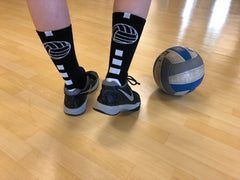The fall season brings volleyball back into many athletes' lives, especially in high schools across the nation. This means it’s time to start practicing those drills that will help you improve your game. In order to do so, it’s important to know not only what equipment you need to bring to volleyball practice, but to also make sure you have the right volleyball apparel and volleyball socks.
Volleyball is a sport where two teams of six players stand on opposite sides of a net placed in the middle of a court. Each team attempts to score points by grounding the ball on the other team’s side of the court. The rules to volleyball are extensive, but in a nutshell, one player of the team begins a “rally” by serving the ball from behind the back border of the court. The ball is then hit over the net and into the other team’s side of the court.
The receiving team can’t let the ball touch the ground on their side of the court. The team can touch the ball up to three times to keep it off the ground, but no one player can touch the ball twice in a row. Usually, the first two touches set up an attack and then the team makes a kill by grounding the ball back into their opponent's side of the court.
The ball is typically hit using hands or arms, but players may legally push or strike the ball with any part of their body. Techniques have evolved over the years to include moves such as spiking, blocking, passing, and setting. There are specialized player positions and defensive and offensive structures for play.
The Origins of Volleyball
In 1895 the physical education director at a YMCA in Holyoke, Massachusetts, named William G. Morgan created a game that he derived from badminton, but took on characteristics from tennis and handball as well. He named it mintonette and designed it to be less rough than basketball, which was invented four years earlier just ten miles away. Mintonette was meant to be played inside and by any number of players. He wanted the older members of the YMCA to have a team sport that could be played inside, but without a lot of athletic effort.
The first rules called for a net down the middle of the court and but didn’t specify the number of players on each team. A mintonette match was composed of nine innings with three serves for each team per inning. There was no limit to the number of contacts the ball had on each side of the court. If a serving error occurred, a second try could be made.
Since its invention, volleyball has had many changes. An observer named Alfred Halstead saw a match played in 1896 and noticed the volleying nature of the game. After that, the game quickly became known as volleyball and the rules were slightly modified by the International YMCA training school.
Volleyball Comes to the Olympics
After additional alterations and refinements over the years, volleyball was introduced to the Olympics in 1964 and has consistently been part of the summer games for both men and women ever since. Since its introduction, the U.S., Soviet Union, and Brazil are the only countries to win multiple gold medals in men’s volleyball. Other countries who have won a gold medal include Poland, Netherlands, Japan, Yugoslavia, and Russia.
Gold medals are even less evenly distributed when it comes to women’s volleyball. Olympic gold medals have only been won by Cuba, Brazil, Soviet Union, Japan, and China.
Even though not many countries have been able to bring home the gold, they all have one thing in common. Every Olympic team has specific volleyball apparel and socks.
Sports Socks and Uniforms
Sports socks are an important staple when it comes to outfitting your volleyball team. They come in both modern and classic styles, including neon colors, team colors, and a variety of designs to help you or your favorite player stand out on the court. Kids love to show their personality and their team spirit. MadSportsStuff has designed its line of volleyball and sports socks around that concept. But their custom volleyball socks don't just offer a variety of designs and colors.
MadSportsStuff started as a family business and has grown over the years. All of their sports socks are made in the USA and they make it a point to tailor all their socks to make sure they fit the needs of the sport you are playing. They are made to wick the sweat away from your feet and withstand the hardest volleyball drills and practices while still being affordable. They're even guaranteed for 30 days!
Volleyball Skills and Conditioning
When preparing for volleyball it’s important for the team members to be conditioned and to master six basic skills and techniques. Those skills include pass, attack, serve, set, dig, and block. These skills have been introduced throughout the history of volleyball, but are now considered a standard, particularly in high-level volleyball.

When it comes to conditioning for volleyball, many coaches use this list of the best volleyball drills for high school as a form of conditioning. Because doing general conditioning can take away from the proper skill techniques, volleyball drills are often designed with the focus being not only on the skill but on conditioning as well.
Conditioning volleyball drills are mostly performed during the off-season or pre-season rather than in-season since during these times executing the proper skills is less important. For example, an in-season team will typically focus on their passing skills in practice and have a separate time or day for conditioning.
Volleyball Drills
The best volleyball drills for high school help players enhance their skills with ball control, timing on jumps for blocks, and footwork. The purpose of volleyball drills may be to improve skills but may also be to fix an existing problem. The best way to perform volleyball drills is to train with purpose. And wearing the proper volleyball apparel to practice is important. Your players want to be able to move and sweat with ease.
Training with purpose will make the players more interested in the training and help develop habits that will improve their ability to focus during competition. Coaches who set goals and specific focus to drills will create a better understanding for their players. The most effective volleyball drills can be broken down into three categories: tactical, systematic, and strategic; skills and movements; and volleyball conditioning specific.
- Skills and Movements – These are the most common types of volleyball drills that players practice under the instruction of their coaches. They are designed to enhance the players' skills through repetition. This is one of the best volleyball drills for high school because it helps with skills such as blocking and setting. By the repetitious practice of the same skills, players develop habits to use when game time comes around. Volleyball drills for beginning players need to focus on executing drills using proper technique. It is easier to develop correct skills early on when first starting to learn the sport, rather than changing techniques once bad habits have been established. Every second spent on the court, whether playing in a pick-up game, practicing, or playing in a competition builds and creates habits.
- Tactical, Strategic, and Systematic – These volleyball drills focus on the execution of the game as a team. They often involve combining skills and using multiple players skills. This means that these drills are most often used after players have each developed their individual skills already. Each coach has a different strategy when it comes to playing volleyball, and each player has different talents, weaknesses, and strengths that help make their team unique. For this reason, these types of volleyball drills often vary from team to team. It is wise for coaches to run their team through drills that are different and unique from what they are used to. This will not only be fun for the players but will spark creativity in the players and help them avoid volleyball burnout.
- Conditioning Drills – Although it may not look like it when watching a volleyball match, volleyball players must be in excellent condition. The sport is a physically-intense game that requires the players to be in superior condition. They need to be able to sprint explosively, jump and hit the ball time and time again, and change directions on a dime. However, most experienced volleyball coaches will agree that typical aerobic workouts, such as jogging, won’t work for volleyball players. Instead, the players should be conditioned during drills, and regular aerobic exercise only is done during the off-season or pre-season.
Team Communication Builds Team Spirit
Every team should include volleyball drills and conditioning that help teach the players to interact and communicate with each other. Drills that require players to call out for a pass or communicating to the attackers where to hit are sure to help bring on success for a volleyball team while building on their skills of passing, serving, setting, attacking, spiking, blocking, and much more.
In addition to good communication, another way to build team spirit is through a team having the same amazing volleyball socks. MadSportsStuff offers custom volleyball socks to match your volleyball apparel and meet the needs of every player on the team. Their designs include a variety of colors, logos, and can even include each players number. Not to mention they’re made to last and constructed right here in the USA.
So, whether you're cheering on your favorite player and need an amazing pair of volleyball or sports socks or gearing up for your first game this fall, check out MadSportsStuff and a wide variety of crazy volleyball socks and other sports socks that we have to offer.











